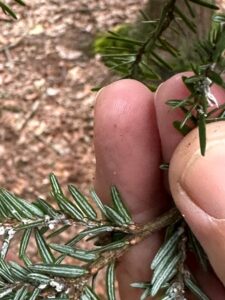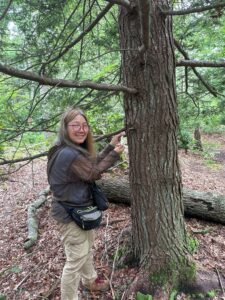
Beetle Release at Hoffman Preserve to Aid in Health of Eastern Hemlock
by Lili Kane, Land Stewardship Intern
Three weeks ago, a small group of Avalonia volunteers and staff joined Dr. Carole Cheah, a research scientist from the Connecticut Agricultural Experiment Station, at Hoffman Preserve in Stonington for an exciting new venture into biocontrol and invasive pest management. As Avalonia’s first foray into biological control organisms, we were full of excitement (and endless questions!). Dr. Cheah’s experience and breadth of knowledge led us confidently, though, as we set off into the woods.

The hemlock wooly adelgid, an insect native to Japan, has caused significant decline in North America’s hemlock populations throughout the past century, including Connecticut’s eastern hemlock (Tsuga canadensis). First observed in the U.S. in Oregon in 1924, the hemlock wooly adelgid (often shortened to HWA) subsist on hemlock needles, killing shoots and branches, and eventually causing the death of the infested tree. Further, the timing of their egg hatches and their ability to overwinter are both temperature dependent processes. This means that mild winters and early warm springs, symptoms of climate change readily apparent in Connecticut, may support their populations. You may have noticed the adelgid while hiking, found on the undersides of hemlock needles, characterized by a white, ‘wooly’ fuzz which serves to protect the eggs. The devastating effects of the HWA, among other stressors, at Hoffman Preserve was part of the reason behind patch cutting of diseased trees in 2018 and subsequent restoration efforts.

Upon our arrival at Hoffman, we gathered near the trailhead, where Dr. Cheah began briefing us on the history and release process of the beetles she studies. Beginning in 1995, the ST or Japanese Lady beetle (Sasajiscymnus tsugae), has been released throughout Connecticut with great success in reducing adelgid populations and promoting healthy hemlock stands. The ST beetle is a specialist organism and consumes wooly adelgid as its primary food source. Unlike many historic tales of biocontrol agents that ultimately became invasive themselves, these beetles have been thoroughly studied for over 35 years and will die after consuming all the available Wooly Adelgid. With plenty of research to back up their efficacy and the complete assurance of Dr. Cheah, we felt confident releasing these tiny black bugs into Avalonia’s backyard.
After entering Hoffman Preserve, Dr. Cheah quickly pointed out potential release spots for the beetles. We were looking for Hemlocks with both visible wool and evidence of overwintered adelgids (black spots). She also recommended releasing along waterways and in edge areas of a Hemlock stand so that the beetles could be carried to other infested trees by water or bird.

Until their release, the ST beetles were held in small containers in a cooler. Within each container was a foam disc, a small ball of straw, and just over 100 beetles. We got to work hanging the disc and straw on our target Hemlocks. After tying them onto small branches, we flipped them, allowing the beetles to fall back onto the needles. What beetles were left in the container, we painted on with brushes. The beetles, Dr. Cheah assured us, will spread easily to other affected trees in their search for food. Once these beetle ‘ornaments’ were hung, we tagged the trees, both physically and digitally, so that with continual monitoring, we can evaluate the success of this release.

Research on this biocontrol strategy has shown that hemlocks within other release sites in Connecticut were able to re-foliate and, overall, showed greater recovery compared to hemlocks without ST beetles. These ‘restored’ trees were comparable to those that had never been infested with the adelgid, with results lasting 15+ years after the initial beetle release. Many people may have (well-reasoned) concerns about using biocontrol agents to reduce invasive impact. In the past, ecologists/biologists have sought silver bullets to solve invasive problems, but with inadequate long-term research and lacking the holistic view of an interconnected ecosystem. With proper planning, research, and release, however, these strategies can not only be effective, but can promote a thriving habitat for successive generations of wildlife (and for us to enjoy!). We are hoping that this beetle release will do just that and are excited to be on the forefront of such innovative, albeit unconventional, restoration research.
